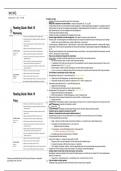Other
READING GUIDE NOTES: WEEK 10 OF BIOCHEMISTRY (BIOSCI98) AT UCI
- Course
- Biochemistry (BIOSCI98)
- Institution
- University Of California - Irvine
Textbook notes corresponding to weekly reading guide of Biochemistry course (code BIOSCI98) at University of California, Irvine. Comes with reading guide and color-coded notes. Week 10.
[Show more]



